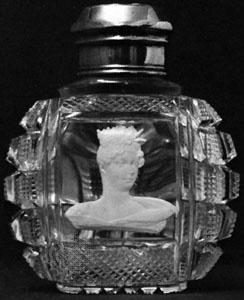crystallo ceramie
glass
also called Cameo Incrustation, Crystal Cameo, or Sulphides,
 cut crystal glass in which a decorative ceramic object is embedded. A Bohemian invention of the 18th century, cameo incrustation was taken up in Paris but had no vogue until Apsley Pellatt, an English glassmaker, developed a technique that resulted in specimens of genuine beauty. In 1819 Pellatt patented his process under the name crystallo ceramie and began to issue his ware from the Falcon Glasshouse in Southwark. His cast bas-relief decorations—which usually were profile portraits of royalty and celebrities or coats-of-arms—were made of a fine white china clay and supersilicate of potash that would not fracture in contact with molten glass. The objects, which have a silvery appearance, are embedded in exceptionally clear flint glass; refraction and illumination from behind are often enhanced by crosscutting and faceting, and outer curves magnify the image. Crystallo ceramie was made in forms such as paperweights, decanters, stoppers, scent bottles, pendants, and various ornamental tableware items.
cut crystal glass in which a decorative ceramic object is embedded. A Bohemian invention of the 18th century, cameo incrustation was taken up in Paris but had no vogue until Apsley Pellatt, an English glassmaker, developed a technique that resulted in specimens of genuine beauty. In 1819 Pellatt patented his process under the name crystallo ceramie and began to issue his ware from the Falcon Glasshouse in Southwark. His cast bas-relief decorations—which usually were profile portraits of royalty and celebrities or coats-of-arms—were made of a fine white china clay and supersilicate of potash that would not fracture in contact with molten glass. The objects, which have a silvery appearance, are embedded in exceptionally clear flint glass; refraction and illumination from behind are often enhanced by crosscutting and faceting, and outer curves magnify the image. Crystallo ceramie was made in forms such as paperweights, decanters, stoppers, scent bottles, pendants, and various ornamental tableware items.Pellatt's work is sometimes referred to as incrusted glass, or incrusted cameos; crystal cameos; or sulphides. The term sulphides, however, is particularly associated with such cameo paperweights as those issued by John Ford & Co., of Edinburgh, about 1875, which were of a quality comparable to Pellatt's and to equally successful work from Baccarat, in France.
- Elisabet Ney
- Elisha
- Elisha ben Abuyah
- Elisha Graves Otis
- Elisha Gray
- Elisha Kent Kane
- Elisha Rice Reed: General Lee at Gettysburg
- elision
- Elista
- Eli Terry
- Eli Whitney
- elixir
- Elizabeth
- Elizabethan literature
- Elizabeth Anne Chase Akers Allen
- Elizabeth Arden
- Elizabeth Barrett Browning
- Elizabeth Barton
- Elizabeth Bishop
- Elizabeth Blackwell
- Elizabeth Bowen
- Elizabeth Cabot Agassiz
- Elizabeth Cady Stanton
- Elizabeth Cady Stanton: The Solitude of Self
- Elizabeth Carter